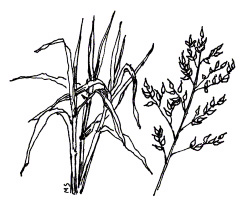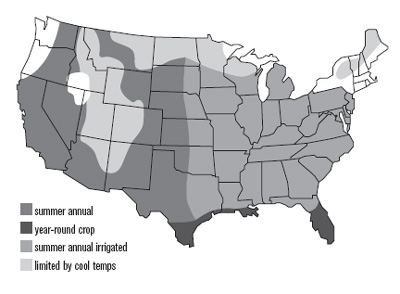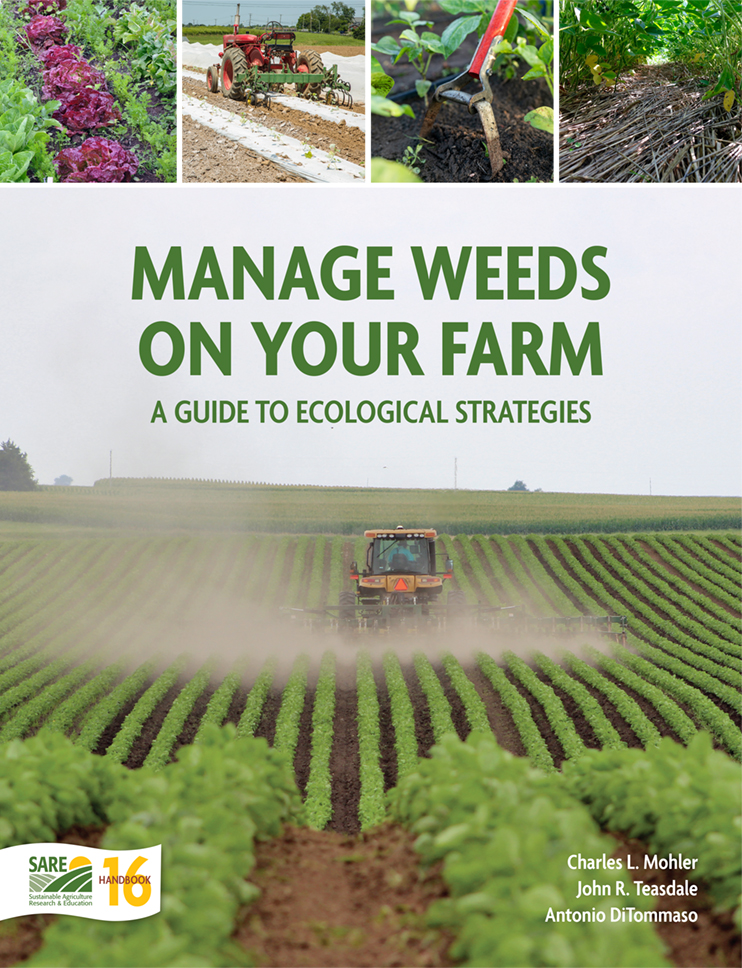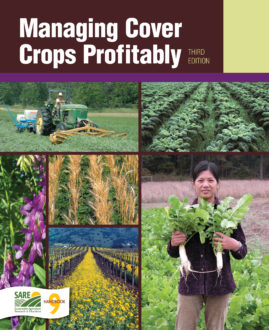
Sorghum Sudangrass Hybrids (Sorghum bicolor x S. bicolor var. sudanese)
Also called: Sudex, Sudax
Type: summer annual grass
Roles: soil builder, weed and nematode suppressor, subsoil loosener
Mix with: buckwheat, sesbania, sunnhemp, forage soybeans or cowpeas
See charts, pp. 66 to 72, for ranking and management summary.
Sorghum-sudangrass hybrids are unrivaled for adding organic matter to worn-out soils. These tall, fast-growing, heat-loving summer annual grasses can smother weeds, suppress some nematode species and penetrate compacted subsoil if mowed once. Seed cost is modest. Followed by a legume cover crop, sorghum-sudangrass hybrids are a top choice for renovating overfarmed or compacted fields.
The hybrids are crosses between forage-type sorghums and sundangrass. Compared with corn, they have less leaf area, more secondary roots and a waxier leaf surface, traits that help them withstand drought (361). Like corn, they require good fertility—and usually supplemental nitrogen—for best growth. Compared with sudangrass, these hybrids are taller, coarser and more productive.
Forage-type sorghum plants are larger, leafier and mature later than grain sorghum plants. Compared with sorghum-sudangrass hybrids, they are shorter, less drought tolerant, and don’t regrow as well. Still, forage sorghums as well as most forms of sudangrass can be used in the same cover-cropping roles as sorghum-sudangrass hybrids. All sorghum- and sudangrass-related species produce compounds that inhibit certain plants and nematodes. They are not frost tolerant, and should be planted after the soil warms in spring or in summer at least six weeks before first frost.

Benefits of Sorghum Sudangrass Cover Crops
Biomass producer. Sorghum-sudangrass grows 5 to 12 feet tall with long, slender leaves, stalks up to one-half inch in diameter and aggressive root systems. These features combine to produce ample biomass, usually about 4,000 to 5,000 lb. DM/A. Up to 18,000 lb. DM/A has been measured with multiple cuttings on fertile soils with adequate moisture.
Subsoil aerator. Mowing whenever stalks reach 3 to 4 feet tall increases root mass five to eight times compared with unmowed stalks, and forces the roots to penetrate deeper.
In addition, tops grow back green and vegetative until frost and tillering creates up to six new, thicker stalks per plant. A single mowing on New York muck soils caused roots to burrow 10 to 16 inches deep compared to 6 to 8 inches deep for unmowed plants. The roots of mowed plants fractured subsoil compaction with wormhole-like openings that improved surface drainage. However, four mowings at shorter heights caused plants to behave more like a grass and significantly decreased the mass, depth and diameter of roots (277, 450, 451).
Weed suppressor. When sown at higher rates than normally used for forage crops, sorghum-sudangrass hybrids make an effective smother crop. Their seedlings, shoots, leaves and roots secrete allelopathic compounds that suppress many weeds. The main root exudate, sorgoleone, is strongly active at extremely low concentrations, comparable to those of some synthetic herbicides (370). As early as five days after germination, roots begin secreting this allelochemical, which persists for weeks and has visible effects on lettuce seedlings even at 10 parts per million (440).
Sorghum-sudangrass hybrids suppress such annual weeds as velvetleaf, large crabgrass, barnyardgrass (126, 305), green foxtail, smooth pigweed (190), common ragweed, redroot pigweed and purslane (316). They also suppressed pine (214) and redbud tree seedlings in nursery tests (154). The residual weed-killing effects of these allelochemicals increased when sorghum-sudangrass hybrids were treated with the herbicides sethoxydim, glyphosate or paraquat, in descending order of magnitude (144).
Nematode and disease fighter. Planting sorghum-sudangrass hybrids instead of a host crop is a great way to disrupt the life cycles of many diseases, nematodes and other pests. For example, when sorghum-sudangrass or sorghum alone were no-tilled into endophyte-infected fescue pastures in Missouri that had received two herbicide applications, the disease was controlled nearly 100 percent. No-till reseeding with endophyte- free fescue completed this cost-effective renovation that significantly improved the rate of gain of yearling steers (16).
Renews farmed-out soils. The combination of abundant biomass production, subsoiling root systems, and weed and nematode suppression can produce dramatic results.
On a low-producing muck field in New York where onion yields had fallen to less than a third of the local average, a single year of a dense planting of sorghum-sudangrass hybrid restored the soil to a condition close to that of newly cleared land (217).
Widely adapted. Sorghum-sudangrass hybrids can be grown throughout the U.S. wherever rainfall is adequate and soil temperature reaches 65° F to 70° F at least two months before frost. Once established, they can withstand drought by going nearly dormant. Sorghum-sudangrass hybrids tolerate pH as high as 9.0, and are often used in rotation with barley to reclaim alkaline soil (421). They tolerate pH as low as 5.0.
Quick forage. Sorghum-sudangrass is prized as summer forage. It can provide quick cover to prevent weeds or erosion where legume forages have been winterkilled or flooded out. Use care because these hybrids and other sorghums can produce prussic acid poisoning in livestock. Grazing poses the most risk to livestock when plants are young (up to 24 inches tall), drought stressed or killed by frost. Toxicity danger varies between cultivars.
Management of Sorghum Sudangrass Cover Crops
Establishment of Sorghum Sudangrass Cover Crops
Plant sorghum-sudangrass when soils are warm and moist, usually at least two weeks after the prime corn-planting date for your area. It will tolerate low-fertility, moderate acidity and high alkalinity, but prefers good fertility and near-neutral pH (361). Standard biomass production usually requires 75 to 100 lb. N/A.
With sufficient surface moisture, broadcast 40 to 50 lb./A, or drill 35 to 40 lb./A as deep as 2 inches to reach moist soil. These rates provide a quicker canopy to smother weeds than lower rates used for forage production, but they require mowing or grazing to prevent lodging. Herbicide treatment or a pass with a mechanical weeder may be necessary if germination is spotty or perennial weeds are a problem. New York onfarm tests show that a stale seedbed method— tilling, then retilling to kill the first flush of weeds just before planting—provides effective weed control.
Warm season mixtures. Plant sorghum-sudangrass in cover crop mixtures with buckwheat or with the legumes sesbania (Sesbania exaltata), sunnhemp (Crotolaria juncea), forage soybeans (Glycine max) or cowpeas (Vigna unguiculata). Broadcast these large-seeded cover crops with the sorghum-sudangrass, then incorporate about 1 inch deep. Fast-germinating buckwheat helps suppress early weeds. Sorghum-sudangrass supports the sprawling sesbania, forage soybeans and cowpeas. Sunnhemp has an upright habit, but could compete well for light if matched with a sorghum-sudangrass cultivar of a similar height.
Field Management for Sorghum Sudangrass Cover Crops
Plants grow very tall (up to 12 feet), produce tons of dry matter and become woody as they mature. This can result in an unmanageable amount of tough residue that interferes with early planting the following spring (277).
Mowing or grazing when stalks are 3 to 4 feet tall encourages tillering and deeper root growth, and keeps regrowth vegetative and less fibrous until frost. For mid-summer cuttings, leave at least 6 inches of stubble to ensure good regrowth and continued weed suppression. Delayed planting within seven weeks of frost makes mowing unnecessary and still allows for good growth before winterkilling (277, 361).
Disking while plants are still vegetative will speed decomposition. Make several passes with a heavy disk or combination tillage tool to handle the dense root masses (277). Sicklebar mowing or flail chopping before tillage will reduce the number of field operations required to incorporate the crop and speed decomposition. Sicklebar mowers cut more cleanly but leave the stalks whole. Using a front-mounted flail chopper avoids the problem of skips where tractor tires flatten the plants, putting them out of reach of a rear-mounted chopper.
Any operations that decrease the residue size shortens the period during which the decomposing residue will tie up soil nitrogen and hinder early planted crops in spring. Even when mowed, residue will become tough and slower to break down if left on the surface.
Flail chopping after frost or killing the cover crop with herbicide will create a suitable mulch for no-till planting, preserving soil life and soil structure in non-compacted fields.
Pest Management for Sorghum Sudangrass Cover Crops
Weeds. Use sorghum-sudangrass to help control nutsedge infestations, suggests Cornell Extension IPM vegetable specialist John Mishanec. Allow the nutsedge to grow until it’s about 4 to 5 inches tall but before nutlets form, about mid-June in New York. Kill the nutsedge with herbicide, then plant the weed-smothering hybrid.
To extend weed suppressive effects into the second season, select a cultivar known for weed suppression and leave roots undisturbed when the stalks are mowed or grazed (440).

Read more about weeds like purple nutsedge and yellow nutsedge in SARE's book: Manage Weeds on Your Farm.
Beneficial habitat. Some related sorghum cultivars harbor beneficial insects such as seven-spotted lady beetles (Coccinella septempunctata) and lacewings (Chrysopa carnea) (421).
Nematodes. Sorghum-sudangrass hybrids and other sorghum-related crops and cultivars suppress some species of nematodes. Specific cultivars vary in their effectiveness on different races of nematodes. These high-biomass-producing crops have a general suppressive effect due to their organic matter contributions. But they also produce natural nematicidal compounds that chemically suppress some nematodes, many studies show.
Timing of cutting and tillage is very important to the effectiveness of nematode suppression. The cover crop needs to be tilled before frost while it is still green. Otherwise, the nematicidal effect is lost. For maximum suppression of soilborne diseases, cut or chopped sudangrass must be well incorporated immediately (308).
For suppressing root-knot nematodes in Idaho potato fields, rapeseed has proven slightly more effective and more dependable than sorghum-sudangrass hybrids (394).
In an Oregon potato trial, TRUDAN 8 sudangrass controlled Columbia root-knot nematodes (Meloidogoyne Chitwoodi), a serious pest of many vegetable crops. Control extended throughout the zone of residue incorporation. The cover crop’s effect prevented upward migration of the nematodes into the zone for six weeks, working as well as the nematicide ethoprop. Both treatments allowed infection later in the season (285).
In the study, TRUDAN 8 sudangrass and the sorghum-sudangrass hybrid cultivars SORDAN 79 and SS-222 all reduced populations of root-knot nematodes. These cultivars are poor nematode hosts and their leaves—not roots—have a nematicidal effect. TRUDAN 8 should be used if the crop will be grazed due to its lower potential for prussic acid poisoning. The sorghum-sudangrass cultivars are useful if the cover crop is intended for anti-nematicidal effects only (285). In other Oregon and Washington trials, the cover crop suppression required supplemental chemical nematicide to produce profitable levels of U.S. No. 1 potatoes (285). These same sudangrass and sorghum-sudangrass hybrid cultivars failed to show any significant nematicidal effects in a later experiment in Wisconsin potato fields (249).
When faced with infestations of the nematodes Meloidogoyne incognita and M. arenaria, Oswego, N.Y., onion grower Dan Dunsmoor found that a well-incorporated sorghum-sudangrass cover crop was more effective than fumigation. Further, the nematicidal effect continued into the next season, while the conditions a year after fumigation seemed worse than before the application. He reports that the sorghum-sudangrass cover crop also controls onion maggot, thrips and Botrytis leaf blight (217).
Insect pests. Chinch bug (Blissus leucopterus), sorghum midge (Contarinia sorghicola), corn leaf aphid (Rhopalosiphum maidis), corn earworm (Heliothis zea), greenbugs (Schizaphis graminum) and sorghum webworm (Celama sorghiella) sometimes attack sorghum-sudangrass hybrids. Early planting helps control the first two pests, and may reduce damage from webworms. Some cultivars and hybrids are resistant to chinch bugs and some biotypes of greenbugs (361). In Georgia, some hybrids hosted corn leaf aphid, greenbug, southern green stinkbugs (Nezara viridula) and leaffooted bug (Leptoglossus phyllopus).
Summer Covers Relieve Compaction
A summer planting of sudangrass was the best single-season cover crop for relieving soil compaction in vegetable fields, a team of Cornell researchers found. Yellow mustard, HUBAM annual white sweetclover and perennial ryegrass also were effective to some extent in the multi-year study. But sudangrass has proven the most promising so far,” says project coordinator David Wolfe. It has shown the fastest root growth.”
“Sudangrass is best managed with one mowing during the season,” Wolfe adds. Mowing promotes tillering and a deep, penetrating root system. Mowing also makes it easier to incorporate the large amount of biomass produced by this crop. With its high C:N ratio, it adds to soil organic matter.
Farmers and researchers have long known that alfalfa’s deep root system is a great compaction-buster. But alfalfa does not establish easily on wet compacted fields, and most vegetable growers can’t afford to remove land from production for two to three years to grow it, notes Wolfe. Many also lack the equipment to subsoil their fields, which is often only a temporary solution, at best. That ’s why Wolfe geared his study to identify cover crops that can produce results in a single season. In the case of heat-loving sudangrass, it also may be possible to squeeze a spring or fall cash crop into the rotation while still growing the cover during summer.
Heavy equipment, frequent tillage and lack of organic matter contribute to compaction problems for vegetable growers in the Northeast, where frequent rains often force growers into the fields when soils are wet. Compacted soils slow root development, hinder nutrient uptake, stunt plants, delay maturity and can worsen pest and disease problems (451). For example, the Cornell researchers found that slow-growing cabbages direct-seeded into compacted soils were vulnerable to flea beetle infestations (450).
Brassica cover crops such as yellow mustard were solid challengers to sudangrass as a compaction reliever, but it was sometimes difficult to establish these crops in the test. We still have a lot to learn about how best to grow brassicas and fit them into rotations with vegetables,” Wolfe says.
Wolfe and his team assessed the cover crops’ effectiveness by measuring yields of subsequent crops and conducting a host of soil quality measurements, including infiltration rates, water-holding capacity, aggregate stability and organic matter levels.
For more information, contact David Wolfe, 607-255-7888; dww5@cornell.edu.
Updated in 2007 by Andy Clark
Crop Systems with Sorghum Sudangrass Cover Crops
There are several strategies for reducing nitrogen tie-up from residue:
- Interplant a legume with the sorghum-sudangrass hybrid.
- Plant a legume cover crop after the sorghum-sudangrass hybrid, in either late summer or the following spring.
- Apply nitrogen fertilizer or some other N source at incorporation and leave the land fallow for a few months when soil is not frozen to allow decomposition of the residue.
If you kill the cover crop early enough in fall, the residue will partially break down before cold temperatures slow biological action (361). Where possible, use sorghum-sudangrass ahead of later planted crops to allow more time in spring for residue to decompose.
Planting sorghum-sudangrass every third year on New York potato and onion farms will rejuvenate soil, suppress weeds and may suppress soil pathogens and nematodes. Working a legume into the rotation will further build soil health and add nitrogen. Sorghum-sudangrass hybrids can provide needed soil structure benefits wherever intensive systems cause compaction and loss of soil organic matter reserves. See Summer Covers Relieve Compaction.
Grown as a summer cover crop that is cut once and then suppressed or killed, sorghum-sudangrass can reduce weeds in fall-planted alfalfa. Sorghum-sudangrass suppressed alfalfa root growth significantly in a Virginia greenhouse study (144), but no effect was observed on alfalfa germination when alfalfa was no-till planted into killed or living sorghum-sudangrass (145).
In Colorado, sorghum-sudangrass increased irrigated potato tuber quality and total marketable yield compared. It also increased nutrient uptake efficiency on the sandy, high pH soils. In this system, the sorghum-sudangrass is grown with limited irrigation, but with enough water so that the biomass could be harvested for hay or incorporated as green manure (112, 113).
In California, some table grape growers use sorghum-sudangrass to add organic matter and to reduce the reflection of light and heat from the soil, reducing sunburn to the grapes.
Comparative Notes
Sorghum-sudangrass hybrids can produce more organic matter per acre, and at a lower seed cost, than any major cover crop grown in the U.S. Incorporated sorghum-sudangrass residue reduces N availability to young crops more than oat residue but less than wheat residue (389).
Cultivars. When comparing sorghum-sudangrass cultivars, consider traits such as biomass yield potential, tillering and regrowth ability, disease resistance, insect resistance (especially if greenbugs are a problem) and tolerance to iron deficiency chlorosis.
If you plan to graze the cover crop, select sorghum-sudangrass hybrids and related crops with lower levels of dhurrin, the compound responsible for prussic acid poisoning. For maximum weed control, choose types high in sorgoleone, the root exudate that suppresses weeds. Sterile cultivars are best where escapes could be a problem, especially where crossing with johnsongrass (Sorghum halpense) is possible.
